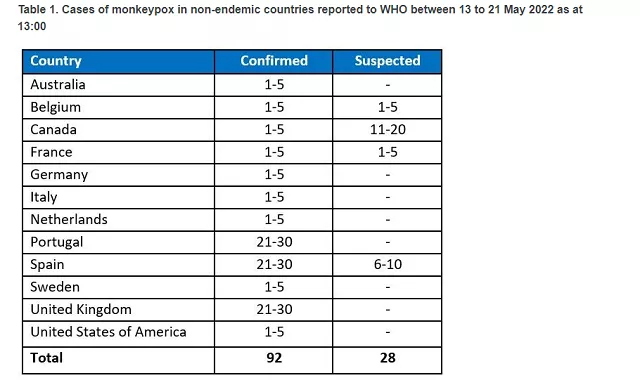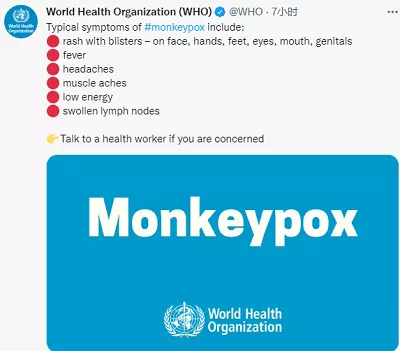As of the press release of China business news on the 22nd, Israel and Switzerland have become the latest two countries with confirmed cases of monkeypox. Previously, on the 21st, the who issued a statement that as of 1 p.m. local time on the same day, 12 non monkeypox endemic countries had reported 92 laboratory confirmed cases and 28 suspected cases to the WHO.
Among these countries, countries outside the European region are Australia, the United States and Canada, European countries are Belgium, France, Germany, Italy, the Netherlands, Portugal, Spain, Sweden and the United Kingdom, and Israel and Switzerland, which have just seen confirmed cases, have a total of 14 countries.
The who said that the situation is changing and it is expected that more monkeypox cases will be found as surveillance expands in non monkeypox endemic countries.
The who also said, "the discovery of confirmed and suspected cases of monkeypox that are not directly linked to travel in endemic areas is a highly unusual event. So far, surveillance in non endemic areas has been limited, but is now expanding. The who expects to report more cases in non endemic areas. Available information indicates that interpersonal transmission is occurring among people in close physical contact with symptomatic cases."

Take immediate action to prevent further dissemination
According to Israeli local media reports, Israel confirmed a 30-year-old man who recently returned from Western Europe and developed monkeypox symptoms. The man had contacted a monkeypox patient abroad and is currently isolated in relevant Israeli hospitals.
Switzerland said that the confirmed man was infected with the virus through "close physical contact abroad". At present, his condition is not serious and is being isolated at home.
According to the who, the countries with monkeypox epidemic are mainly in Africa. To this end, who believes that the current situation in non monkeypox endemic countries is unusual.
The who said the focus of immediate action was to provide accurate information to those most likely to be infected with monkeypox to prevent further transmission.
"The evidence currently available suggests that the most dangerous people are those who have had close physical contact with patients with monkeypox who have symptoms." So far, all confirmed cases have been infected with the West African strain, the who said. The genome sequence of swab samples from confirmed cases in Portugal shows that the monkeypox virus leading to the current epidemic is very close to the cases exported from Nigeria to the UK, Israel and Singapore in 2018 and 2019.
The who explained that monkeypox is a viral zoonotic disease. Its symptoms are very similar to those seen in smallpox patients in the past and are not clinically serious.
Monkeypox is caused by monkeypox virus belonging to the genus orthopoxvirus of poxviridae. There are two different virus strains: Congo Basin strain and West Africa strain. Congo Basin strain is highly toxic.
The name monkeypox comes from 1958, when the virus was first found in monkeys in Danish laboratories. In 1970, the first human case was found in a child in the Democratic Republic of the Congo.
The incubation period of monkeypox (the time interval between infection and symptoms) is usually 6 to 16 days, but can be 5 to 21 days. Monkeypox virus spreads from one person to another through close contact with contaminated materials such as lesions, body fluids, respiratory droplets and bedding.
Infection can be divided into two stages: onset (0-5 days): fever, severe headache, lymphadenopathy (lymphadenopathy), back pain, myalgia (muscle pain), severe fatigue and weakness (low spirits); Rash stage (within 1-3 days after fever): rash in different stages often starts from the face and then spreads to other parts of the body. The most common skin rashes were on the face (95% of cases), palms and soles of feet (75%). The rash changes from maculopapular (flat lesions at the bottom) to small blisters (small blisters filled with liquid) and pustules. The scab will form after about 10 days and disappear after about three weeks.
The number of lesions varies from a few to thousands, affecting the oral mucosa (70% of cases), genitalia (30%), conjunctiva (eyelid) (20%) and cornea (eyeball).
It is worth noting that some patients will develop severe lymphadenopathy (lymphadenopathy) before the rash, which can help to identify monkeypox, because other similar diseases do not have this feature.
The condition is usually self limiting, but can be severe in some individuals, such as children, pregnant women, or people with immunosuppression due to other health conditions. The disease caused by human infection in West Africa strain is slightly lighter, with a case fatality rate of 3.6%, while the case fatality rate caused by Congo Basin strain is 10.6%.
The who said it had determined that a variety of animals were sensitive to monkeypox virus. The natural history of monkeypox virus is still uncertain, and further research is needed to determine the exact host and how the virus maintains circulation in nature. Eating undercooked meat and other animal products from infected animals is a possible risk factor.
It is likely that more cases with unknown transmission chain will be found
Who stressed that the current phenomenon is atypical. Therefore, there is an urgent need to improve the understanding of monkeypox and conduct comprehensive case discovery and isolation.
Is there a targeted vaccine? The who said cross protective immunization against smallpox vaccination would be limited to the elderly, as people under the age of 40 or 50 worldwide no longer benefit from the protection provided by previous smallpox vaccination programmes. Young people living in non monkeypox endemic countries have little immunity to monkeypox because the virus is not there.
However, the who also said that historically, smallpox vaccination has been proved to prevent monkeypox. Although a vaccine (mva-bn) and a specific treatment (tecovirimat) were approved for monkeypox in 2019 and 2022 respectively, these countermeasures have not been widely used.
The who also said in another information note that several observational studies have shown that smallpox vaccination is about 85% effective in preventing monkeypox. Therefore, previous smallpox vaccination may lead to mild illness.
The who said no deaths had been reported in the current confirmed cases. However, due to limited monitoring, the extent of local transmission is unclear at this stage.
"It is likely to find more cases with unknown transmission chains." Who warned.
Who recommends that any patient suspected of monkeypox should be investigated. If confirmed, they should be isolated until their lesions scab, scab fall off and form a new layer of skin below.
The who also said that countries should be alert to the signals associated with patients with atypical rashes, which progress to rashes, papules, blisters, pustules, scabs, and may be accompanied by fever, enlarged lymph nodes, back pain and muscle soreness.
